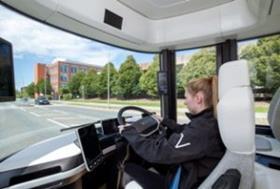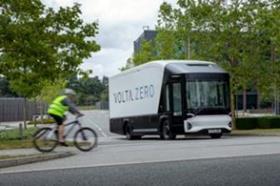
Anglo-Swedish electric vehicle start up Volta Trucks has officially launched its 16-tonne GVW battery electric urban delivery truck, the Volta Zero. Designed as an EV from the ground up, CEO Rob Fowler said the vehicle was “available now to meet customers’ desire to decarbonise”.
The company has already taken orders for 12 vehicles from customers including Fowler's former employer DPD to take part in a pilot in the UK and France in H1 2021 and expects to build 500 units in 2022 once the vehicle has been proven in operation.
“The technology has moved a long way since the early days of electric vehicles,” said Fowler. “We are running a pilot fleet next year to make sure this is a good solid product.”
The Zero uses biodegradable lightweight flax and resin composite body panels, developed in conjunction with the European Space Agency, and can carry 8,600kgs in a load volume of 37.7 cu m, accommodating up to 16 500kg Euro pallets. Volta has opted for 16 tonne GVW rather than the more conventional 3.5 or 7.5 tonnes popular with many urban operators because the extra capacity makes the vehicle more appealing to a wider audience.
“There is a requirement for all types of freight to move into cities, not just parcels,” said Fowler. “One Volta can carry the same payload as two 7.5 tonners so it helps reduce congestion as well as emissions.”

Fowler said the radical design of the Zero was not just about electrification. The truck sits the driver low and central in a “glasshouse” cab to give 220-degree direct vision which is enhanced by rear-view cameras replacing the mirrors, a 360-degree birds-eye view camera and blind-spot warning systems covering the sides of the vehicle.
“We have redesigned the whole cab structure because we have no legacy from diesel vehicles,” he said. “This is as much about safety and driver retention as electrification.
“We know that going electric can be a real challenge so we are offering all our experience and knowledge not just a truck. It will not be a case of ‘buy our truck and see you later’.”
While larger fleets will be able to buy the Zero outright, Volta wants to attract smaller operators by offering a complete package called Truck as a Service that wraps the vehicle, R&M, insurance and training into a monthly fee. Volta is working with “two or three” partners to assist fleet operators develop on-site recharging and Fowler said the intention was to recharge in depots rather than en route or at drivers’ homes.
The truck is designed to run for 95 to 125 miles on a single charge with 160 to 200kWh of battery capacity.

“The Zero is designed for city centres so it will not be going a long way,” said Fowler. “The stated range is real world with no inflation and we have done a lot of work to understand typical duty cycles, whether single or double shift.”
Rather than the conventional electric motor and driveshaft it uses an e-Axle to drive the rear wheels, which is claimed to be lighter and more efficient, helping to increase range. It also frees up space between the chassis rails allowing the batteries to be mounted in the safest place.
The modular batteries are lithium iron phosphate, also claimed to be safer than the more typical nickel cobalt manganese, which should deliver the promised range for at least 10 years.
The Zero will be rolled out across the UK city by city, starting with London, and Volta will develop an in-house R&M network as its coverage grows.
What’s it like to drive? Commercial Motor deputy editor George Barrow gets a view from the Zero cab
The Volta Zero lays claim to some impressive statistic, reducing CO2 and creating numerous jobs, as many as 130, from its UK-based supply chain. Sitting in the central seat you get a commanding view of your surroundings with narrow A-pillars of around 250mm and similarly size B-pillars, for the door uprights, being the only obstructions in a view that lets you look beyond 180-degrees behind you thanks to the forward driving position.
The seat height also puts you in the direct eye-line of pedestrians, which should hopefully increase safety. Build quality on this production models appears high, with large upright display screens (currently Apple iPads) either side of the steering wheel for navigation and vehicle information and more traditional readouts on a horizontal digital dash ahead. One thing missing, however, is a lack of storage.
While this might be an urban distribution vehicle, its driver won’t be devoid of possessions and three coat hangers, as well as two cupholders either side of the steering wheel, and a cupholder next to each of the rear passenger seats, are unlikely to be sufficient – you have to question if the designer has spent any real time speaking with drivers.
As an early production model it shows promise and while impressive overhead lighting panels and chunky grab handles on the dash at side of the cabin add to the aesthetics, the functional aspect of the left and right steps being different sizes (altering your head height on entry or exit) could be cause for concern if during a busy multidrop shift the driver were to misjudge their approach. Like the electric powertrain technology it is championing, the Volta Zero is in its infancy as an HGV.














